Hasselblad 205TCC, 205FCC, 203FE Service Manual
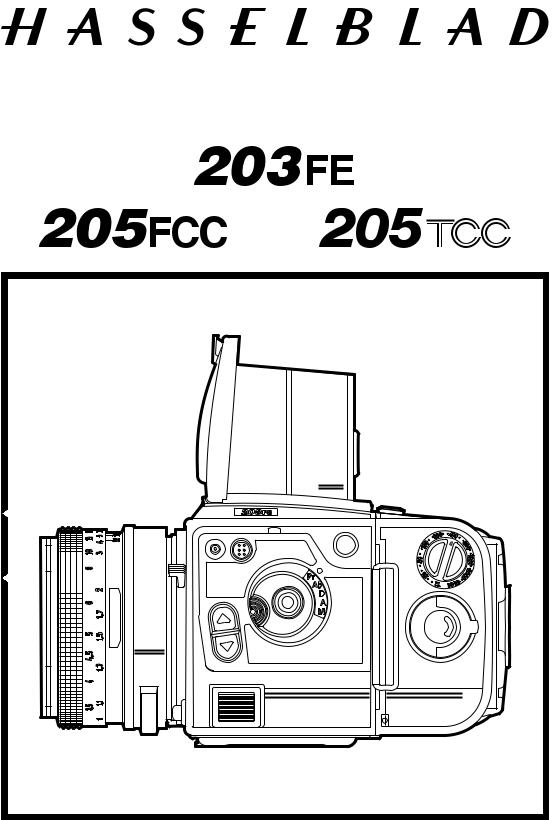
|
203FOMSL.EPS |
Service Manual |
203FE, omslag |
SVART |
|
960130 |
|
|
May 1997
Victor Hasselblad AB
Göteborg Sweden
Copyright © 1997 by Victor Hasselblad AB. All rights reserved. No parts of this material may be reproduced, stored in retrieval system or transmitted, in any form or by any means, electronic, mechanical, photocopy, recording, or
COPYRIGHT © 1996 ANDERS ENGSTRÖMotherwise, without the prior written permission of the Company.
ANDERS ENGSTRÖM, ILLUSTRATÖR Östra vägen 46
430 91 HÖNÖ TEL/FAX 03196 84 64
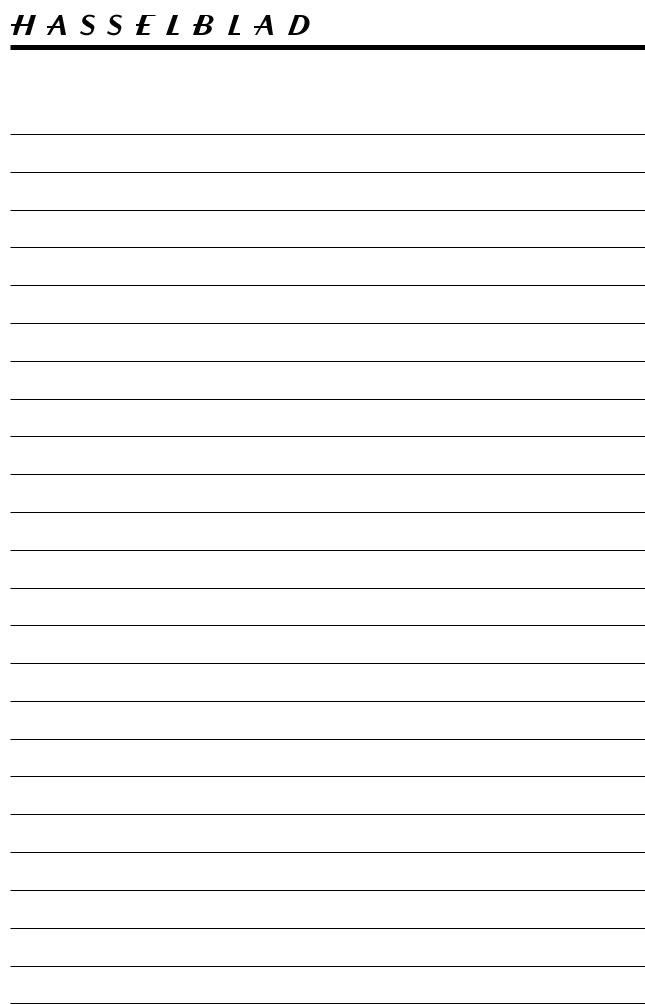
Contents list
Camera body 203FE - 205FCC - 205TCC
1. General description
2. Specifications
3. Checks & Adjustments
4. Tools & ServiceTest System
5. Exploded view: Shell
6. Exploded view: Control panel, mechanics
7. Exploded view: Control panel, electronics
8. Exploded view: Display flex and main circuit board
9. Exploded view: Contact flex and transport mechanism plate
10. Exploded view: Transport mechanism plate
11. Exploded view: Front bayonet plate
12. Exploded view: Curtains and rear plate
13. Exploded view: Mirror assembly
14. Exploded view: Display prism and fucusing screen
15. Exploded view: Chassis
16. Exploded view: Reflection protectors
17. Exploded view: Bottom mechanism plate, mechanics
18. Exploded view: Bottom mechanism plate, brakes
19. Exploded view: Bottom mechanism plate, electronics
20. Exploded view: Spring housing
21. Exploded view: Winding crank
22. Exploded view: Winding crank - modified from May 1997
Revision 0 |
May 1997 |

Related Service Infos
203FE - 205FCC - 205TCC |
1. |
03/92 |
New Service Manual |
05/92 |
Service Manual 205TCC System Components |
|
|
04/93 |
Some more hand tools are now available |
|
|
05/93 |
The release button and buffer have recently been modified - 205TCC |
|
|
12/93 |
Just for your information |
|
|
13/93 |
Hasselblad 205TCC |
|
|
21/93 |
Camera body 205TCC and Magazine TCC |
|
|
09/94 |
The control panel has recently been redesigned - 205TCC |
|
|
10/94 |
New camera body - 203FE |
|
|
03/95 |
New tool - Support 904020 |
|
|
05/95 |
New tripod foot - 203FE |
|
|
14/95 |
Mirror and focusing screen adjustment 200 series cameras |
|
|
19/95 |
New camera body - 205FCC |
|
|
24/95 |
Incorrect spare part number - 205TCC |
|
|
28/95 |
New tool - Adapter 904759 |
|
|
01/96 |
Contact flex modified - 203FE |
|
|
03/96 |
Driving arm failed to latch - 203FE and 205FCC |
|
|
12/96 |
Tripod foot adapter/kits |
|
|
04/97 |
Light seal foil modified - 200 series cameras |
|
|
13/98 |
New Service Manual - 203FE, 205FCC and 205TCC |
|
|
08/99 |
New control panel - 205TCC |
|
|
13/99 |
Modified parts - 200 series cameras |
|
|
01/00 |
New CD-ROM - Version 1.2 |
|
|
Revision 3 |
January 2001 |

Related Service Infos
203FE - 205FCC - 205TCC |
2. |
14/00 |
Discontinued parts - 200 series cameras |
01/01 |
Modified magazine hook - 203FE and 205FCC |
|
|
04/01 |
New CD-ROM - Version 2.0 |
|
|
|
|
|
|
|
|
|
|
|
|
|
|
|
|
|
|
|
|
|
|
|
|
|
|
|
|
|
|
|
|
|
|
|
|
|
|
|
|
|
|
Revision 0 |
January 2001 |
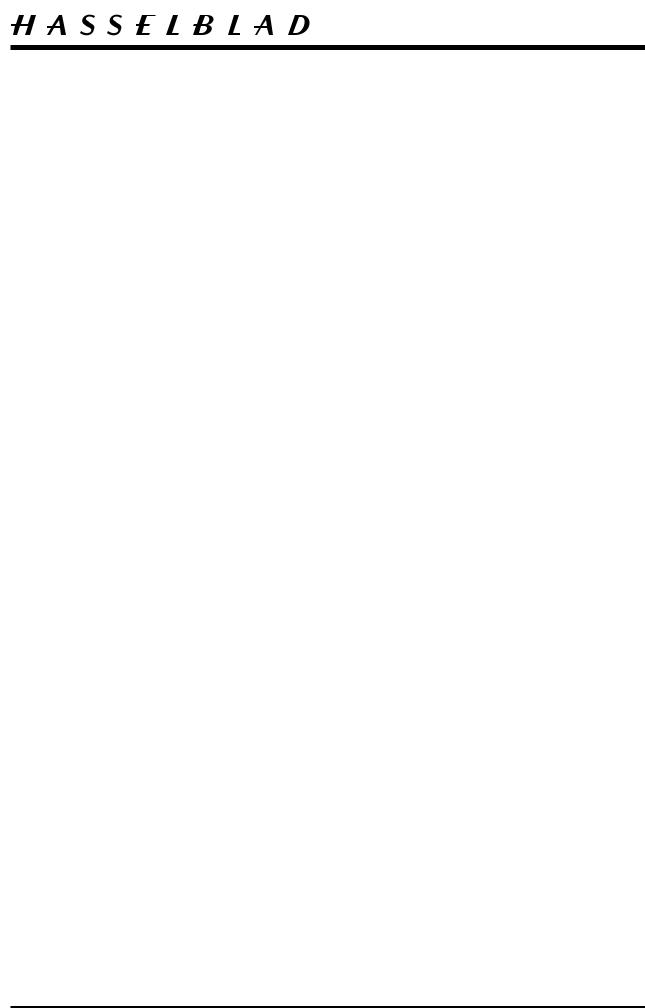
General description 1:1
Camera body 203FE - 205FCC - 205TCC
Design: |
Medium format single reflex camera with built-in TTL selective |
|
meter electronically connected to FE lenses and E magazines. |
|
Interchangeable lenses, film magazines, viewfinders and |
|
focusing screens. |
Shutter: |
Electronically controlled mechanical focal plane shutter with |
(203FE/205FCC) |
release solenoid system. Horizontally running textile curtains. |
|
Shutter speed range 90 s - 1/2000 s and B. In manual mode up |
|
to 34 minutes. Fully mechanical C setting for lenses with |
|
built-in leaf shutters. |
|
Flash synchronization at all speeds from B to 1/90 s. |
Shutter: |
Electronically controlled mechanical focal plane shutter with |
(205TCC) |
release solenoid system. Horizontally running textile curtains. |
|
Shutter speed range 16 s - 1/2000 s and B. Fully mechanical C |
|
setting for lenses with built-in leaf shutters. |
|
Flash synchronization at all speeds from B to 1/90 s. |
Lens mount: Hasselblad bayonet mount for FE, F, CF and C lenses. Contacts for data-bus communication with the FE lenses.
Viewfinder: Focusing hood with 4 x magnifier, interchangeable with magnifying hood and prism viewfinders with or without exposure meter. Acute-Matte focusing screen interchangeable with other Hasselblad focusing screens. Illuminated flash and warning symbols.
Display: |
LCD display with all relevant exposure and operational data. |
|
Switch-controlled low light illumination. |
Winding & |
Manual single turn winding crank. Simultaneous shutter |
film advance: |
cocking and film advance. The crank is interchangeable with |
|
the Hasselblad Winder for a frame rate of up to 1.3 fps. |
Revision 0 |
May 1997 |
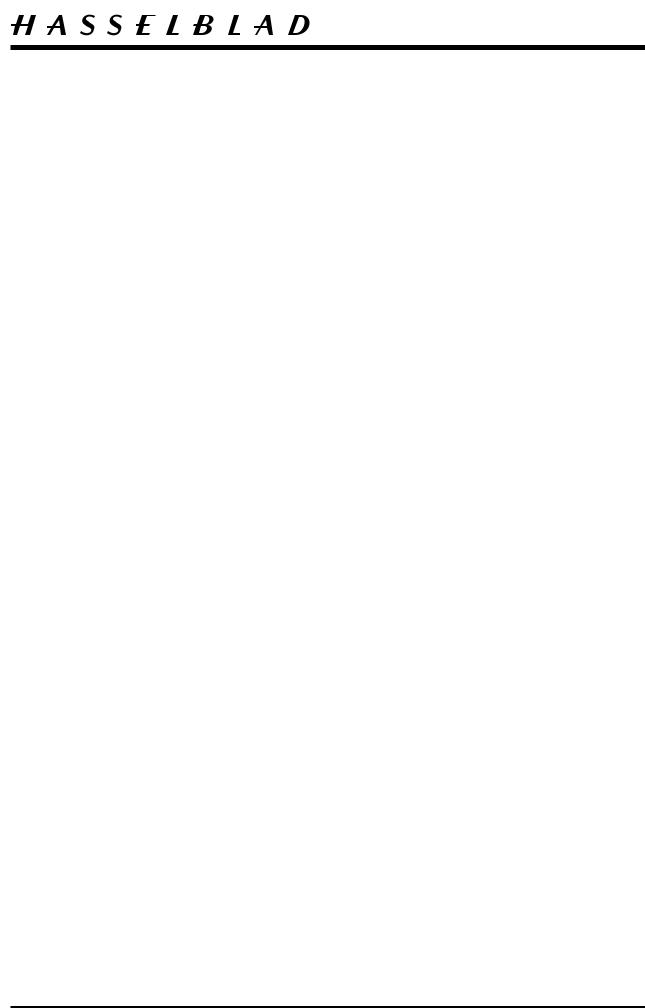
General description 1:2
Camera body 203FE - 205FCC - 205TCC
Exposure meter: TTL metering at full aperture with FE lenses. High sensitivity (203FE) silicon photocell. Selective meter area approximately 20% of
the image area. Metering range EV 0.5 to EV 21.5 at ISO 100/21° and f 2.8.
Activated 16 s after release of any operational button.
Exposure meter: TTL metering at full aperture with FE lenses. High sensitivity (205FCC/205TCC) silicon photocell. Spotmeter area approximately 1% of the
image area. Angle of view from approximately 1° to 7° depending on the lens focal length.
Metering range EV -1 to EV 20 at ISO 100/21° and f 2.8. Activated 16 s after release of any operational button.
Exposure functions: Aperture priority automatic exposure, automatic flash control (203FE) and full manual control. Exposure compensation ± 5 EV in 1/3
EV increments. AE-lock.
Exposure functions: Aperture priority automatic exposure, automatic flash control (205FCC/205TCC) and full manual control. Exposure compensation ± 5 EV in 1/4
EV increments. AE-lock.
Operating modes: |
Programming, Automatic bracketing, Differential, Automatic |
(203FE) |
and Manual mode. |
Operating modes: |
Programming, Automatic bracketing, Differential, Zone and |
(205FCC) |
Manual mode. |
Operating modes: |
Automatic, Programming, Differential, Zone and |
(205TCC) |
Manual mode. |
Film speed range: ISO 12/12° - 6400/39°, selected with film speed dial on E and CC magazines or set in programming mode.
Revision 0 |
May 1997 |

General description 1:3
Camera body 203FE - 205FCC - 205TCC
Flash control: |
Center weighted TTL/OTF flash exposure meter. Full |
(203FE/205FCC) |
dedicated flash control with inhibited flash triggering at shutter |
|
speeds faster than 1/90 s. |
|
Flash control film speed range ISO 25 - 1000. |
Flash control: |
Center weighted TTL/OTF flash exposure meter. Full |
(205TCC) |
dedicated flash control with automatic shutter speed reset |
|
to 1/90 s at faster speed settings. Inhibited flash triggering at |
|
shutter speeds settings faster than 1/90 s with non-dedicated |
|
flash units. |
|
Flash control film speed range ISO 25 - 1000. |
Self timer: |
Default delay 10 s. Programmable delay in 12 steps from |
|
2 s to 60 s. |
Battery: |
6 volt, type PX28 Lithium. |
Tripod mount: |
Quick coupling plate with 1/4" and 3/8" socket thread. |
(203FE/205FCC) |
|
Tripod mount: |
Quick coupling plate with 1/4" socket thread. |
(205TCC) |
|
External |
|
dimensions: |
91L x 118W x 110H (3 9/16 x 4 21/32 x 4 1/32 in). |
(203FE/205FCC) |
|
External |
|
dimensions: |
91L x 118W x 108H (3 9/16 x 4 21/32 x 4 1/4 in). |
(205TCC) |
|
Weight: |
745 g. |
|
|
Revision 0 |
May 1997 |

Specifications 2:1
Camera body 203FE - 205FCC - 205TCC
Focal length: |
|
71.4 mm ± 0.03 mm |
||
Front key angle: |
Cocked position |
8° - 9° |
3 Ncm |
|
|
Overtravel |
12° - 14° |
14 Ncm |
|
Front gear: |
Pre-tension of spring |
3 turns (released position) |
||
Magnets: |
Minimum hold |
2 Ncm |
|
|
Shutter: |
Accelerating stretch |
6.5 - 8.1 mm |
||
|
Slot |
0.2 - 1.0 mm |
||
|
Travel times |
9.5 - 9.7 ms at 1/2000 s (0 ± 0.07 ms) |
||
|
Speeds 1 sec - 1/60 |
± 0.1 EV |
|
|
|
Speeds 1/90 - 1/2000 |
± 0.3 EV |
|
|
Light meter: |
All settings |
± 0.3 EV |
|
|
Flash meter: |
All settings |
± 0.3 EV |
|
|
Flash sync: |
Delay |
0 - 0.20 ms |
||
Current consumption: |
On |
max 10 mA at 5.6 V |
||
|
Off |
max 20 uA at 5.6 V |
||
|
|
|
|
|
Revision 0 |
|
|
May 1997 |
|

Specifications 2:2
Camera body 203FE - 205FCC - 205TCC |
Switch functions |
PPS = Pressure point switch
Makes when the release button is pressed to the pressure point. Activates the camera. A pre-locked light value is unlocked when the button is released.
LRS = Late release switch
Makes when the release button is fully pressed. Starts together with PPS an exposure.
HPS = Home position switch
Makes when the camera is fully cocked. Indicates together with FSS that the camera is tensioned. If HPS is open, the camera can not be activated.
FSS = First curtain sync switch
Will be switched off when the first curtain is released. Indicates together with HPS that the camera is tensioned. If FSS is open, the camera can not be activated.
SSS = Second curtain sync switch
Will be switched off when the second curtain is released. Must be closed, otherwise the warning function: Lo Flash and Hi Flash in C-mode will not work.
FKS = Front key switch
Makes when the camera is tensioned. Is switched off when the mirror goes up and at that time also prevents new light values to be stored. If FKS is not switched off the selftimer does not work.
MRS = Mirror release switch
Makes when the mirror release button is fully pressed. When the button is pressed once more, the selftimer starts. In B-mode the second curtain will be released when MRS is switched off.
ELS = Exposure lock switch
Activates the camera when pressed. When released, a light value is stored.
Revision 0 |
May 1997 |

Specifications 2:3
Camera body 203FE - 205FCC - 205TCC |
Switch functions |
TC1.EPS
960201
AS+ = |
Adjustment switch + |
|
|
Exposure compensation etc. |
|
AS- = |
Adjustment switch - |
|
|
Exposure compensation etc. |
|
VFS = |
View finder switch |
|
|
Is switched off when a prism finder is mounted on to the camera and at the same |
|
|
time mirror turns the display. |
203SWTC |
|
|
|
BLS = |
Back light switch |
|
|
ON/OFF display illumination. |
|
FSS
SSS
HPS
VFS |
LRS |
|
BLS |
PPS
COPYRIGHT © 1996 |
ANDER |
ANDERS ENGSTRÖ M, ILLUST |
|
MRS |
|
Ö stra vägen 46 |
|
430 91 HÖ NÖ |
TEL/FA |
ELS
AS+
FKS |
AS- |
|
Revision 0 |
May 1997 |
1996 ANDERS ENGSTRÖ M
TRÖ M, ILLUSTRATÖ R
TEL/FAX 031-96 84 64

Checks & Adjustments 3:1
Camera body 203FE - 205FCC - 205TCC |
Link to: VHABSTS |
CAUTION! When handling the circuit boards a grounded bench mat and a wrist strap must be used to prevent ESD damage.
Carry out the following checks/adjustments when a camera body is reassembled after a repair.
Note! Point 1 - 7 without camera shell.
1.The camera body focal length is checked by using the gauge V-2229 together with the ruler and indicator clock. The focal length is 71.40 mm ± 0.03 mm. Adjustment slots on the chassis and the bottom mechanism plate.
2.* Secure the camera in the gauge V-2229 by the adapter 904759. Check the 45º
mirror angle with the sighting tube. The image seen, should be symmetrical. Adjust, if necessary, the four supports in the mirror box by using the tools 901046 (front supports) and 904018 (rear supports).
3.* Check the flatness of the screen. Use the screen adapter V-4705 and the ruler with the indicator clock. The same measurement should be obtained at all four corners.
Adjust, if necessary, by the four screws (Pos No. 28, page 15).
4.* After the screen is correctly levelled the height must also be checked. Use the collimator V-4151, the screen adapter V-4705 and the microscope V-2236.
The image seen in the microscope should be the red line central between the two green lines. Recheck the flatness.
5.Use the tool 902658 or V-2075/2151 for checking of the front key angle. Adjust if necessary. Cocked position 8° - 9° 3 Ncm. Overtravel 12° - 14° 14 Ncm.
6.Temporarily fit the control panel to the camera body and secure it with a piece of tape. Use the nut driver 903755 or 903474.
7.Connect the camera body to the Service Test System and go through all checks in the given order according to the 203/205 menu. Note! pos. 7:1 to 7:7 without sensor head and light source.
7:1 CAMERA STATUS. Make sure all switches are working properly. Note! The speed ring in C-position.
If the contact flex has been removed at any time, the timing between the pre-release switch (PRS) and the mirror must be checked.
Mount the test shell, 905002, with four screws. Fit the exposure gauge V-2354 in the release button and slowly rotate the micrometer clockwise and observe when the mirror is released. At the same time (not before) the PRS should change from "open" to "closed" on the screen. A slight delay is acceptable. This corresponds to 1.5 divisions on the scale.
Adjust, if necessary, by altering the position of the rear section of the contact flex
Revision 3 |
February 2000 |
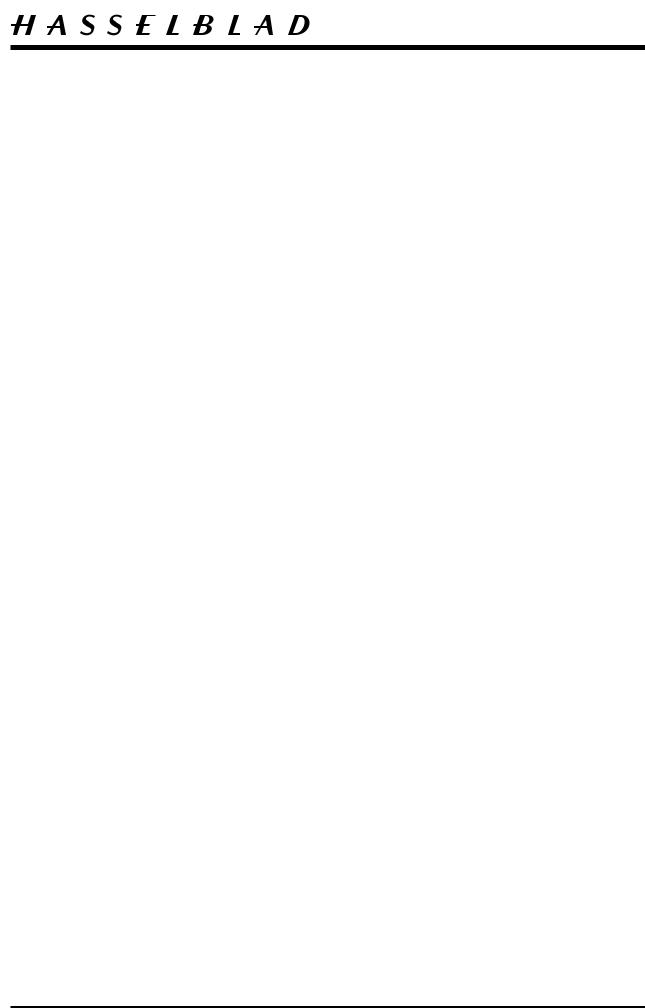
Checks & Adjustments 3:2
Camera body 203FE - 205FCC - 205TCC
containing the PRS. Untighten the two screws (Pos. No. 12, page 9) and carefully change the position of the flex in the direction required. Tighten the screws and recheck.
7:2 PANEL. Check the control panel functions.
7:3 SPEED RING. Make sure all speed ring settings are indicating correctly.
7:4 DISPLAY. Check the display indications. Note! To get the flash indicator to light up, the sync cable must be connected.
7:5 CURRENT. Check the consumption (max. 10 mA at 5.6 volt) and the drain (max. 20 uA at 5.6 volt).
7:6 LENS. Check the communication between a lens and the camera body. (F-stops)
7:7 MAGAZINE. Check the communication between a magazine and the camera body.
7:8 SHUTTER. Start by adjusting the travel times. Use 1/2000 sec. and adjust the spring housing until both curtains have a speed between 9.5 - 9.7 ms. (0 ± 0.07 ms).
At this point, also make a final adjustment of the braking mechanism if necessary. The brake is checked as follows: Release the camera. Rotate the 2nd shutter gear (Pos No. 25, page 17) and count the number of times the catch (Pos No. 4, page 18) and the brake plate (Pos No. 3, page 18) engage. (Min. 4 times). For an adjustment use the nut driver 903755 or 903474. (See page 3:4).
Check/adjust the speed 1/2000 sec. Use the "shutter speed" potentiometer for an adjustment. (See page 3:4). Max. deviation ± 0.3 EV.
Check the speed 1/1000 sec. Max. deviation ± 0.3 EV.
7:9 LIGHT METER. Check/adjust the light meter. Use the "light meter" potentiometer for an adjustment. (See page 3:4). Max deviation ± 0.3 EV. Do not use any
other light output except EV 15, since the camera is not built in to the shell.
7:10 FLASH SYNC. Check/adjust the flash sync. The delay is adjusted to 0 - 0.20 ms by altering the position of the first sync contact. (See page 3:4).
7:11 FLASH METERING. Check/adjust the flash meter. Use the "flash meter" potentiometer for an adjustment. (See page 3:4). Max. deviation ± 0.3 EV. Use the setting ISO 100 and light output EV 15.
7:12 C-POSITION. Check/adjust the C-position. It is adjusted by extending/shortening the release arm 103389. (See page 3:4).
Revision 1 |
June 1998 |

Checks & Adjustments 3:3
Camera body 203FE - 205FCC - 205TCC
8.Remove the control panel. Make sure the four centering screws (Pos. No. 16 and 19, page 11) are screwed in and put the camera body in to the shell.
Do not forget the pre-release button.
9.After aligning the rear plate/shell tighten the two rear screws (Pos No. 32, page 5) and adjust, if necessary, the horizontal relationship between the speed ring and the shell by the screws (Pos No. 16, page 11) which are accessible through the shell.
10.Adjust the vertical relationship between the speed ring and the shell by the screws (Pos No. 19, page 11) which are accessible through the shell and then tighten the two front screws (Pos No. 34, page 5).
11.Check the upper edge alignment of rear plate and shell. Adjust, if necessary, by the two screws (Pos No. 31, page 9) which are accessible through the shell .
Note! The rear edge of the shell must not protrude over the rear plate at any point.
12.Remount the control panel, the winding crank mechanism, the tripod foot, the speed ring grip and the inner cover. (The inner cover by using the tool 901061).
13.* When the camera body is fully reassembled, recheck the focal length, the 45° mirror angle and the screen position.
14.Connect the camera body to the Service Test System once again and go through all checks once more. Minor adjustments are sometimes necessary to make.
At this stage, it is also possible to use different light outputs when checking the light and flash meter since the camera body is mounted in to the shell.
*The 200 series cameras are built slightly different from the 500 series cameras concerning the focusing screen adjustment. Due to the use of high precision test equipment at the assembly line, deviations from perfect 45º mirror angle is compensated for when adjusting the focusing screen position. Doing so we assure minimum focusing differences over the full image format between the images on the focusing screen and on the film.
The result of the factory screen adjustment is, that the screen position may not be totally horizontal when tested in the gauge V-2229. This is still quite in order.
When servicing the 200 series cameras we recommend not to change the mirror angle, provided it is in tolerance when checked with the sighting tube in gauge V-2229. Deviations from perfect 45º angle has already been accompanied by nonhorizontal focusing screen position.
However, if the mirror angle is out of tolerance, adjustment has to be made using the current procedures. (Service Info No. 14/1995)
Revision 1 |
June 1998 |

Checks & Adjustments 3:4
Camera body 203FE - 205FCC - 205TCC
203FADJM.EPS 203FE, adjustments
960130
Curtain brakes
2nd curtain drive spring
1st curtain drive spring
COPYRIGHT © 1996 ANDERS ENGSTR Ö M
ANDERS ENGSTRÖ M, ILLUSTRATÖ R Ö stra vägen 46
430 91 HÖ NÖ TEL/FAX 031-96 84 64
|
|
– |
– |
+ |
+ |
|
|
|
+ |
– |
|
+ –
–
– |
+ |
+ –
–
Sync contacts
C-position
Shutter speed 1/2000 sec
Light meter
Flash meter
Revision 0 |
May 1997 |

Checks & Adjustments 3:5
Camera body 203FE - 205FCC - 205TCC
Magnet hold capability
The magnet hold capability can be checked according to the diagram below. A suitable scale, like the ZZ88, should be used. When measuring, it must indicate minimum 2 NCM (200 gram) before each latching lever is released.
If indicating less then 2 NCM, the magnets should be cleaned and then rechecked. If still less then 2 NCM after cleaning the Bottom mechanism plate, compl. (Part No. 105028) must be changed. Magnets and latching levers are not available as spare parts due to sensitive calibration procedures.
|
1 |
1 |
200 |
|
50 |
|
|
|
|
|
|
|
250 |
|
|
|
|
GRAM |
|
50 |
|
|
250 |
|
|
|
200 |
||
|
1 |
1 |
|
|
|
|
|
||
|
|
|
|
VHAB Tool No. = ZZ88, Scale
The magnets can be released from the main circuit board when troubleshooting. Use an external DC power supply and apply 5 volt to the test points indicated. Do not forget the grounding.
Magnet 2 |
Magnet 1 |
|
|
Revision 0 |
May 1997 |

Tools 4:1
Camera body 203FE - 205FCC - 205TCC
Tool No. |
Description |
Used for |
V-2211 |
Pin driver |
Fitting the locating pin in the front plate |
|
|
and the front gear bracket |
V-2229 |
Focal length gauge |
Adjustment of the focal length, the |
|
|
mirror 45ºangle and the focusing screen |
V-2236 |
Microscope |
Focusing screen adjustment |
V-2354 |
Exposure gauge |
Adjustment of the timing between the |
|
|
pre-release switch (PRS) and the mirror |
V-4151/52 |
Focusing tester |
Focusing screen adjustment |
V-4705 |
Focusing screen adapter |
Focusing screen adjustment |
901 044 |
Centering pin |
Positioning the front gear bracket |
901 045 |
Centering pin |
Positioning the front gear bracket |
901 046 |
Bender |
Adjustment of the mirror 45º angle |
901 061 |
Mounting tool |
Mounting the inner cover |
902 658 |
Key angle gauge |
Adjustment of the front key angle |
903 282 |
Key |
Securing a nut on the bottom plate |
903 570 |
Shutter gear holder |
Securing the shutter gears when fitting |
|
|
the curtains |
|
|
|
Revision 0 |
|
April 1998 |

Tools 4:2
Camera body 203FE - 205FCC - 205TCC
Tool No. |
Description |
Used for |
903 630 |
Bender |
Adjustment of the late release switch |
903 755 |
Nut driver |
Fitting the control panel and the |
|
|
contact flex to the main circuit board |
903 940 |
Key |
Cocking the curtains before the |
|
|
intermediate gear is fitted |
904 018 |
Bender |
Adjustment of the mirror 45º angle and |
|
|
the auxiliary mirror position |
904 020 |
Supporting tool |
Protecting the control panel and the |
|
|
main circuit board when working on |
|
|
the right hand side of the camera |
904 759 |
Adapter |
To be used in combination with focal |
|
|
length gauge V-2229 |
905 002 |
Test shell |
Adjustment of the timing between the |
|
|
pre-release switch (PRS) and the mirror |
970 600 |
Service Test System |
See page 4:3 |
905 138 |
Light box |
See page 4:3 (optional) |
ZZ89 |
Driver |
To tighten the special type allen |
|
|
screw holding the chassis and the front |
|
|
plate together |
Revision 0 |
April 1998 |
